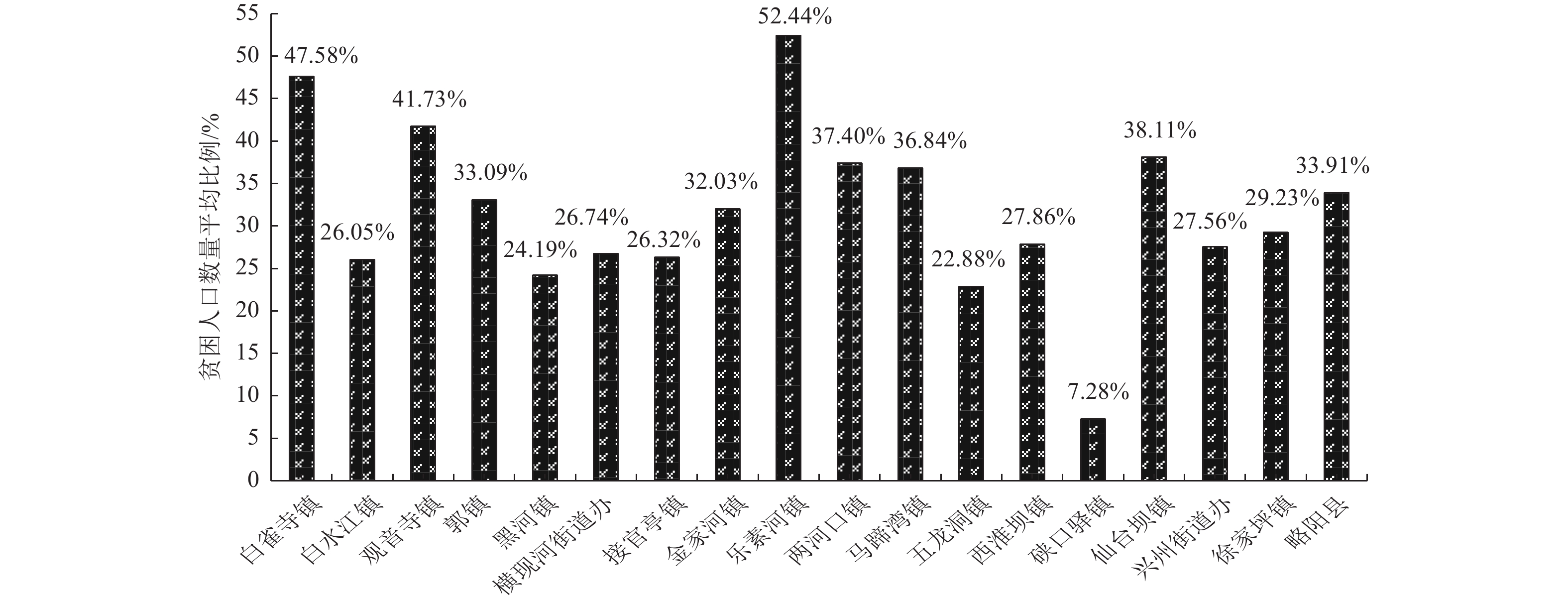Investigation and Evaluation of Earthquake Resistance of Rural Houses in Lueyang County
-
摘要: 为精准识别贫困山区农居房屋结构现状完好程度,本文开展略阳县境内41894栋农居房屋抗震现状实地调查,搜集整理域内孕灾环境和致灾因子强度,统计分析域内各行政镇(办)经济水平、农居房屋抗震结构类型和震害等级,预测震害矩阵,计算平均震害指数,并评价抗震能力。研究结果表明:域内农居房屋抗震结构类型包括土木结构、砖木结构和砖混结构;域内农居房屋在VI度地震作用下基本完好的比例为74.04%,在VII度地震作用下发生轻微破坏以下震害等级的比例为83.45%,在VIII度地震作用下发生中等破坏以下震害等级的比例为85.46%;域内农居房屋在地震烈度为VI、VII、VIII、IX、X度时的平均震害指数分别为0.13、0.23、0.32、0.49、0.71,抗震性能较差,不满足“小震不坏、中震可修、大震不倒”的抗震设防目标。Abstract: To precisely evaluate the earthquake-resistance properties of hilly rural buildings, a total of 41894 rural buildings in Lueyang County were censored and investigated, in which disaster-inducing factors, disaster-pregnant environment were collected. Based on these economic development levels, structure types of the rural buildings, and earthquake hazard grades in this county were also investigated to predict the earthquake hazards matrix, earthquake hazard index and earthquake-resistance capacity of the rural buildings. The results show there are three types of rural buildings with reference to earthquake-resistance capacity: mud-wood structure, brick-wood structure and brick-concrete structure. For the rural buildings investigated, under earthquake-intensity of VI, VII and VIII, percents of the intact rural buildings, and slightly destroyed buildings and medium-destroyed buildings are 74.04%, 83.45%, 85.46%. And under the earthquake-intensity of VI, VII, VIII, IX and X, the mean hazard index are 0.13, 0.23, 0.32, 0.49 and 0.71, indicating the investigated buildings have a bad performance in earthquake-resistance. And the the investigated buildings do not meet the requirement of the aim of earthquake resistanceof “no damage under minor earthquake, repairable under medium earthquake, no collapsing under major earthquake”.
-
表 1 略阳县地震动参数
Table 1. Seimic ground motion parameters of Lueyang
行政镇(办)
名称地震动峰值
加速度/g反应谱特征
周期/s地震基本
烈度行政镇(办)
名称地震动峰值
加速度/g反应谱特征
周期/s地震基本
烈度白雀寺镇 0.15 0.4 VII度 两河口镇 0.15 0.4 VII度 白水江镇 0.15 0.4 VII度 马蹄湾镇 0.15 0.4 VII度 观音寺镇 0.15 0.4 VII度 五龙洞镇 0.15 0.4 VII度 郭镇 0.20 0.4 VIII度 西淮坝镇 0.20 0.4 VIII度 黑河镇 0.15 0.4 VII度 硖口驿镇 0.15 0.4 VII度 横现河街道办 0.15 0.4 VII度 仙台坝镇 0.15 0.4 VII度 接官亭镇 0.15 0.4 VII度 兴州街道办 0.15 0.4 VII度 金家河镇 0.20 0.4 VIII度 徐家坪镇 0.15 0.4 VII度 乐素河镇 0.15 0.4 VII度 略阳县 0.15 0.4 VII度 表 2 建筑破坏等级与震害指数
Table 2. The relation between gradation of earthquake damage and damage index
破坏等级 震害程度 震害指数di 基本完好 承重和非承重构件完好或个别非承重构件轻微破坏,不加修理可继续使用 $ 0.00\leqslant {\text{d}}_{{i}} < 0.\text{10 }{\text{,可取}}\text{0}\text{.00} $ 轻微破坏 个别承重构件出现可见裂缝,个别非承重构件轻微损坏,不需要修理或稍加修理可继续使用 $ 0.10\leqslant {\text{d}}_{{i}} < 0.\text{30 }{\text{,可取}}\text{0}\text{.20} $ 中等破坏 多数承重构件出现轻微裂缝,少数有明显裂缝,个别非承重构件破坏严重,需要一般修理后可使用 $0.30\leqslant {\text{d} }_{ {i} } < 0.\text{5}5\text{ }{\text{,可取} }0.40$ 严重破坏 多数承重构件破坏较严重,非承重构件局部倒塌,房屋修复困难 $ 0.55\leqslant {\text{d}}_{{i}} < 0.\text{8}5\text{ }{\text{,可取}}\text{0}\text{.70} $ 毁坏 多数承重构件严重破坏,结构濒于崩溃或已倒毁,已无修复可能 $ 0.85\leqslant {\text{d}}_{{i}}\leqslant 1\text{ }\text{.00}{\text{,可取}}\text{1}\text{.00} $ 表 3 农居房屋震害等级统计结果(单位:%)
Table 3. The statistics of earthquake damage grade of rural houses (Unit:%)
行政镇(办)名称 破坏等级 基本完好 轻微破坏 中等破坏 严重破坏 毁坏 白雀寺镇 44.46 22.52 15.17 10.65 7.20 白水江镇 57.19 24.36 13.05 3.67 1.72 观音寺镇 62.00 25.00 12.00 1.00 0 郭镇 32.98 37.65 28.47 0.71 0.19 黑河镇 61.44 24.92 12.11 1.31 0.22 横现河街道办 62.00 25.00 12.00 1.00 0 接官亭镇 54.18 23.96 13.66 5.34 2.86 金家河镇 32.21 33.86 31.66 1.65 0.61 乐素河镇 61.98 25.00 12.00 1.01 0 两河口镇 62.00 25.00 12.00 1.00 0 马蹄湾镇 61.76 24.97 12.05 1.13 0.10 五龙洞镇 62.00 25.00 12.00 1.00 0 西淮坝镇 28.15 50.23 20.00 1.35 0.28 硖口驿镇 54.17 23.95 13.63 5.34 2.91 仙台坝镇 62.00 25.00 12.00 1.00 0 兴州街道办 61.94 24.99 12.01 1.03 0.02 徐家坪镇 60.66 24.81 12.25 1.74 0.54 略阳县 58.88 24.57 12.61 2.72 1.21 表 4 VI度地震时农居房屋震害矩阵(单位:%)
Table 4. Seismic damage matrix of VI-degree earthquake (Unit:%)
行政镇(办)名称 破坏等级 基本完好 轻微破坏 中等破坏 严重破坏 毁坏 白雀寺镇 59.96 22.56 10.46 6.24 0.96 白水江镇 72.55 20.80 4.94 1.47 0.26 观音寺镇 77.00 20.00 3.00 0 0 郭镇 76.98 20.00 3.01 0.01 0 黑河镇 76.46 20.09 3.24 0.19 0.03 横现河街道办 77.00 20.00 3.00 0 0 接官亭镇 69.72 21.28 6.18 2.45 0.43 金家河镇 77.00 20.00 3.00 0 0 乐素河镇 76.99 20.00 3.01 0 0 两河口镇 77.00 20.00 3.00 0 0 马蹄湾镇 76.77 20.04 3.10 0.08 0.01 五龙洞镇 77.00 20.00 3.00 0 0 西淮坝镇 77.00 20.00 3.00 0 0 硖口驿镇 69.66 21.26 6.20 2.50 0.43 仙台坝镇 77.00 20.00 3.00 0 0 兴州街道办 76.95 20.01 3.02 0.02 0 徐家坪镇 75.71 20.20 3.57 0.47 0.07 略阳县 74.04 20.48 4.30 1.04 0.17 表 5 VIII度地震时农居房屋震害矩阵(单位:%)
Table 5. Seismic damage matrix of VIII-degree earthquake (Unit:%)
行政镇(办)名称 破坏等级 基本完好 轻微破坏 中等破坏 严重破坏 毁坏 白雀寺镇 14.42 25.31 28.76 15.92 15.59 白水江镇 17.83 31.35 34.38 11.03 5.42 观音寺镇 19.00 33.70 36.40 8.70 2.20 郭镇 16.79 19.59 14.50 38.09 11.02 黑河镇 18.86 33.43 36.16 8.95 2.61 横现河街道办 19.00 33.70 36.40 8.70 2.20 接官亭镇 17.07 29.89 33.09 12.40 7.55 金家河镇 16.80 19.60 14.50 38.10 11.00 乐素河镇 19.00 33.69 36.39 8.71 2.21 两河口镇 19.00 33.70 36.40 8.70 2.20 马蹄湾镇 18.94 33.58 36.30 8.81 2.38 五龙洞镇 19.00 33.70 36.40 8.70 2.20 西淮坝镇 16.80 19.60 14.50 38.10 11.00 硖口驿镇 17.05 29.89 33.07 12.34 7.65 仙台坝镇 19.00 33.70 36.40 8.70 2.20 兴州街道办 18.99 33.67 36.38 8.73 2.23 徐家坪镇 18.65 33.06 35.82 9.26 3.21 略阳县 18.21 32.19 35.06 10.08 4.45 表 6 农居房屋结构平均震害指数
Table 6. Average seismic damage index of rural housing structure
行政镇(办)名称 地震烈度 VI度 VII度 VIII度 IX度 X度 白雀寺镇 0.25 0.30 0.43 0.58 0.77 白水江镇 0.14 0.25 0.33 0.50 0.72 观音寺镇 0.11 0.24 0.30 0.47 0.70 郭镇 0.20 0.35 0.47 0.61 0.70 黑河镇 0.11 0.26 0.30 0.48 0.70 横现河街道办 0.11 0.19 0.30 0.47 0.70 接官亭镇 0.17 0.29 0.35 0.52 0.73 金家河镇 0.21 0.32 0.47 0.62 0.70 乐素河镇 0.11 0.21 0.30 0.47 0.70 两河口镇 0.11 0.21 0.30 0.47 0.70 马蹄湾镇 0.11 0.25 0.30 0.48 0.70 五龙洞镇 0.11 0.25 0.30 0.47 0.70 西淮坝镇 0.19 0.31 0.47 0.59 0.70 硖口驿镇 0.17 0.30 0.35 0.52 0.73 仙台坝镇 0.11 0.25 0.30 0.47 0.70 兴州街道办 0.11 0.22 0.30 0.47 0.70 徐家坪镇 0.12 0.21 0.31 0.48 0.71 略阳县 0.13 0.23 0.32 0.49 0.71 -
[1] 高晓路, 季珏, 金凤君等, 2012. 中国农村房屋震灾脆弱性评估及其成因分析. 地理学报, 67(2):211—220. doi: 10.11821/xb201202007Gao X. L., Ji J., Jin F. J., et al, 2012. Seismic vulnerability of rural housing and regional anti-disaster strategies in China. Acta Geographica Sinica, 67(2): 211—220. (in Chinese) doi: 10.11821/xb201202007 [2] 郭光玲, 2020. 陕南村镇住宅结构体系抗震能力评价研究——以汉中市留坝县为例. 震灾防御技术, 15(1):56—66. doi: 10.11899/zzfy20200106Guo G. L., 2020. Research on evaluation of seismic capability of rural residential structure system in southern Shaanxi Province——in the case of Liuba County, Hanzhong City. Technology for Earthquake Disaster Prevention, 15(1): 56—66. (in Chinese) doi: 10.11899/zzfy20200106 [3] 国家市场监督管理总局, 国家标准化管理委员会, 2020.GB/T 17742—2020 中国地震烈度表. 北京: 中国标准出版社.State Administration for Market Regulation, Standardization Administration, 2020. GB/T 17742—2020 The Chinese seismic intensity scale. Beijing: Standards Press of China. (in Chinese) [4] 黄艳, 2019. 湖南省农村民居地震安全研究进展. 自然灾害学报, 28(2):37—48.Huang Y., 2019. Review of research on seismic safety of rural residences in Hunan province, China. Journal of Natural Disasters, 28(2): 37—48. (in Chinese) [5] 李孝波, 薄景山, 李平等, 2013. 地震烈度异常研究的若干进展. 地震学报, 35(3):430—440. doi: 10.3969/j.issn.0253-3782.2013.03.014Li X. B., Bo J. S., Li P., et al., 2013. Some progress of study on abnormality of seismic intensity. Acta Seismologica Sinica, 35(3): 430—440. (in Chinese) doi: 10.3969/j.issn.0253-3782.2013.03.014 [6] 梁永朵, 姜金征, 张文静等, 2018. 辽宁省地震重点监视防御区典型村镇房屋抗震现状调查与分析. 世界地震工程, 34(3):103—110.Liang Y. D., Jiang J. Z., Zhang W. J., et al., 2018. Investigation and analysis on the seismic status of typical rural houses in the key earthquake monitoring and defending regions in Liaoning province. World Earthquake Engineering, 34(3): 103—110. (in Chinese) [7] 孙佳伟, 2012. 略阳县地质灾害风险评价研究. 西安: 长安大学.Sun J. W., 2012. Study on regional geological disaster risk assessment: a case study of Lueyang County, Shanxi Province. Xi’an: Chang’an University. (in Chinese) [8] 唐皓, 赵法锁, 宋飞, 2015. 陕西地震灾区滑坡类型及其时空分布特征——以略阳县为例. 中国地质灾害与防治学报, 26(1):9—15.Tang H., Zhao F. S., Song F., 2015. Types and spatio-temporal distribution of landslides in the area effected by “5.12” Wenchuan earthquake in Shaanxi province——a case study in Lueyang country. The Chinese Journal of Geological Hazard and Control, 26(1): 9—15. (in Chinese) [9] 陶文翔, 2019. 江西村镇房屋抗震性能与加固方法研究应用. 南昌: 南昌大学.Tao W. X., 2019. Research and application of seismic performance and reinforcement of rural building in Jiangxi Province. Nanchang: Nanchang University. (in Chinese) [10] 姚新强, 孙柏涛, 陈宇坤等, 2017. 我国农居抗震能力研究现状. 建筑结构, 47(S1):578—582.Yao X. Q., Sun B. T., Chen Y. K., et al., 2017. Study on distribution of seismic capacity of Tianjin rural residence. Building Structure, 47(S1): 578—582. (in Chinese) [11] 尹之潜, 1996a. 结构易损性分类和未来地震灾害估计. 中国地震, 12(1):49—55.Yin Z. Q., 1996a. Classification of structure vulnerability and evaluating earthquake damage from future earthquake. Earthquake Research in China, 12(1): 49—55. (in Chinese) [12] 尹之潜, 1996b. 地震灾害及损失预测方法. 北京: 地震出版社. [13] 中华人民共和国国家质量监督检验检疫总局, 中国国家标准化管理委员会, 2009. GB/T 24335—2009 建(构)筑物地震破坏等级划分. 北京: 中国标准出版社.General Administration of Quality Supervision, Inspection and Quarantine of the People’s Republic of China, Standardization Administration, 2009. GB/T 24335—2009 Classification of earthquake damage to buildings and special structures. Beijing: Standards Press of China. (in Chinese) [14] 中华人民共和国国家质量监督检验检疫总局, 中国国家标准化管理委员会, 2016. GB 18306—2015 中国地震动参数区划图. 北京: 中国标准出版社.General Administration of Quality Supervision, Inspection and Quarantine of the People’s Republic of China, Standardization Administration, 2016. GB 18306—2015 Seismic ground motion parameters zonation map of China. Beijing: Standards Press of China. (in Chinese) [15] 中华人民共和国住房和城乡建设部, 2008. JGJ 161—2008 镇(乡)村建筑抗震技术规程. 北京: 中国建筑工业出版社.Ministry of Housing and Urban-Rural Development of the People’s Republic of China, 2008. JGJ 161—2008 Seismic technical specification for building construction in town and village. Beijing: China Architecture & Building Press. (in Chinese) [16] 中华人民共和国住房和城乡建设部, 中华人民共和国国家质量监督检验检疫总局, 2009. GB 50023—2009 建筑抗震鉴定标准. 北京: 中国建筑工业出版社.Ministry of Housing and Urban-Rural Development of the People’s Republic of China, General Administration of Quality Supervision, Inspection and Quarantine of the People’s Republic of China, 2009. GB 50023—2009 Standard for seismic appraisal of buildings. Beijing: China Architecture & Building Press. (in Chinese) [17] 中华人民共和国住房和城乡建设部, 中华人民共和国国家质量监督检验检疫总局, 2016. GB 50011—2010 (2016版) 建筑抗震设计规范. 北京: 中国建筑工业出版社.Ministry of Housing and Urban-Rural Development of the People’s Republic of China, General Administration of Quality Supervision, Inspection and Quarantine of the People’s Republic of China, 2010. GB 50011—2010 Code for seismic design of buildings. Beijing: China Architecture & Building Press. (in Chinese) [18] 周强, 闵全环, 熊拥军等, 2018. 江西典型村镇既有房屋抗震性能分析. 自然灾害学报, 27(1):96—105.Zhou Q., Min Q. H., Xiong Y. J., et al., 2018. Seismic performance analysis of existing typical rural buildings in Jiangxi. Journal of Natural Disasters, 27(1): 96—105. (in Chinese) [19] 周扬, 2013. 略阳县地质灾害气象预报预警. 西安: 长安大学.Zhou Y., 2013. The study of westher early warning for geological disaster in Lueyang Country. Xi’an: Chang’an University. (in Chinese) [20] 邹博, 肖遥, 李伟等, 2019. 盖州地区农居抗震能力调查. 防灾减灾学报, 35(3):22—27.Zou B., Xiao Y., Li W., et al., 2019. The seismic capacity investigation on the rural dwellings in Gaizhou Area. Journal of Disaster Prevention and Reduction, 35(3): 22—27. (in Chinese) -




 下载:
下载:



